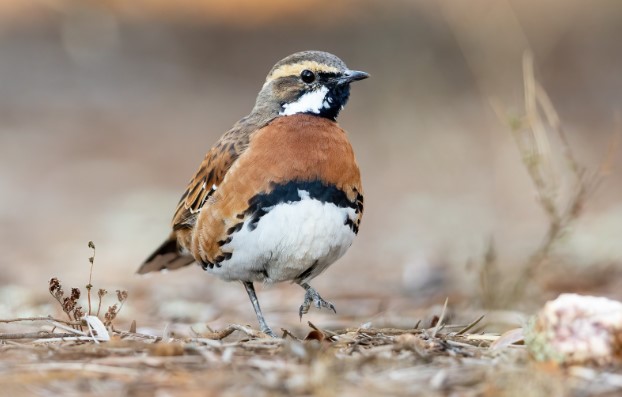Chestnut-breasted Quail-thrush (Cinclosoma castaneothorax) is a patchy mulga, and Mallee woodland on hard or stony ground is the habitat of this slender bird, which occurs in two widely isolated populations, one in central eastern Australia and the other through central Western Australia.
This bird is also known as the Western quail-thrush. Separated by the dune systems of the Simpson and Strzelecki Deserts, their origin and divergence from a pan-central Australian ancestor probably date from the development of those deserts. The birds forage on the ground in ones, dispersed pairs, or small parties like other quail-thrushes, methodically walking a wayward, meandering path, picking up insects and seeds, and keeping contact with occasional thin, high whistles.

If they are disturbed, they may squat out of sight beneath a bush or run, dodging off through shrubbery. When flushed, they whirr up and dash off in rocketing bursts, white tail tips spreading and flashing. Breeding pairs establish a territory each season, the male signaling it with sporadic song throughout the day from the top of a shrub. Only the female nest builds, incubates, and broods the young, which she has to leave to feed herself The male later assists with the feeding of chicks and so, too, may other females.
Read More: Red-backed Button-quail (Turnix maculosa)
The size of Chestnut-breasted Quail-thrush is about 220-240 mm in length, while the male is slightly larger. MALE: Head russet-brown grading to dark rufous overall upper parts, browner in the east. The wing coverts are black, broadly tipped white; all flight feathers are dusky, edged rufous. Tail feathers except for central dark rufous pair black. The outer four pairs tipped broadly white. The eyebrow is cream in color and has a broad white stripe over the cheeks to the side of the neck. Lores and throat black. Upper breast and flanks mid (west) or dark (east) rufous, bordered on lower edge by broad (west) or narrow (east) black line; belly white; undertail marked black-and-white. Eyes are dark red-brown. Bill is black. The feet are grey.
The female is as male; wing coverts are duskier, face greyer, lower cheeks and throat buff, breast washed grey (west) or russet-brown (east), a white belly without black border and ill- (west) or well- (east) defined, undertail mottled rufous-brown and white. The immature female is duller and flecked dusky over head to back and from throat to breast and flanks.
Read More: Painted buttonquail (Turnix varius)
The call of Chestnut-breasted Quail-thrush consists of several thin, very high-pitched, slurred whistles in contact or alarm. While the song consists of a series of short, soft but far-carrying, slightly down-slurred whistles on the same pitch,.
Nesting and breeding occur regularly in July–September, as well as other times depending on rain. Nest a shallow scrape under a bush formed of bark strips, grass, twigs, and leaves into a cup. The bird lays two or three eggs, pale- to buff-grey, peppered with brown and underlying blue-grey spots; oblong oval, about 29 x 20 mm. Females are responsible for the incubation process.
Chestnut-breasted Quail-thrush is mainly found in open acacia or mallee scrub on hardpan or stony ground, in central Western Australia, from Pilbara, through the Gibson Desert to central Australia, and in Diamantina-Cooper-Bulloo-Darling drainages. There are two races; one in each region.

Read More: Stubble Quail (Coturnix pectoralis)






